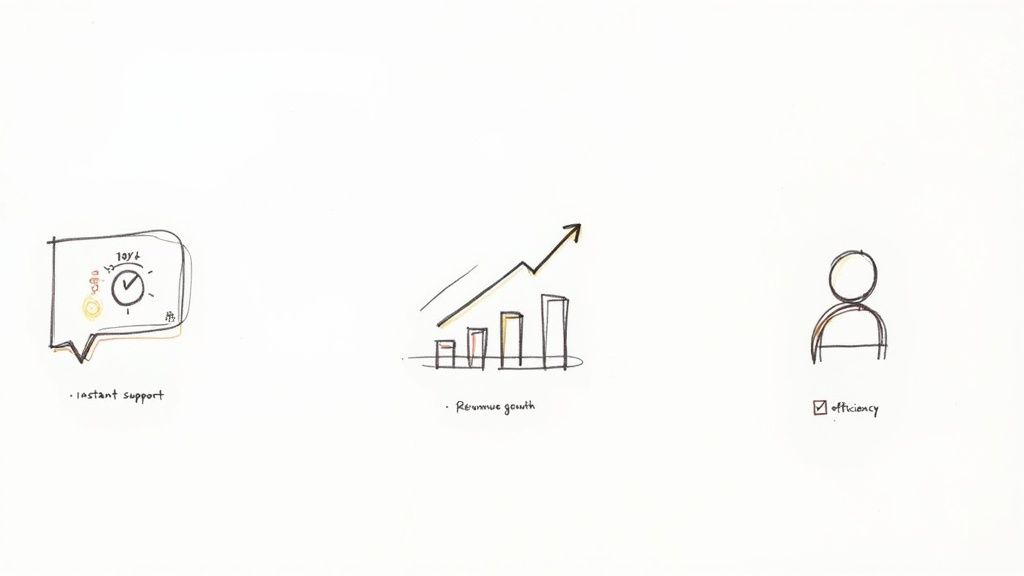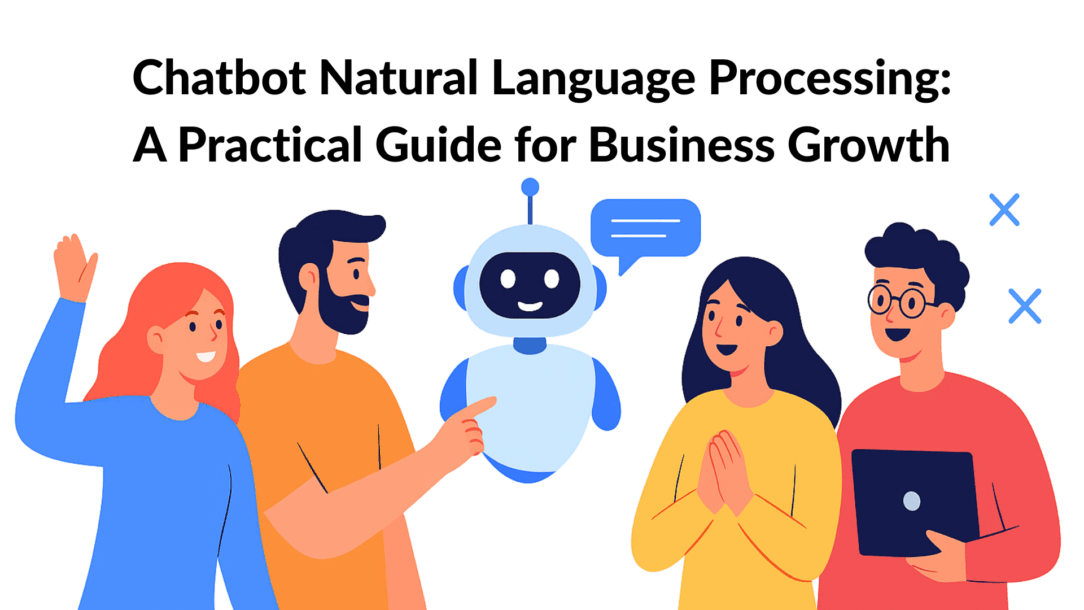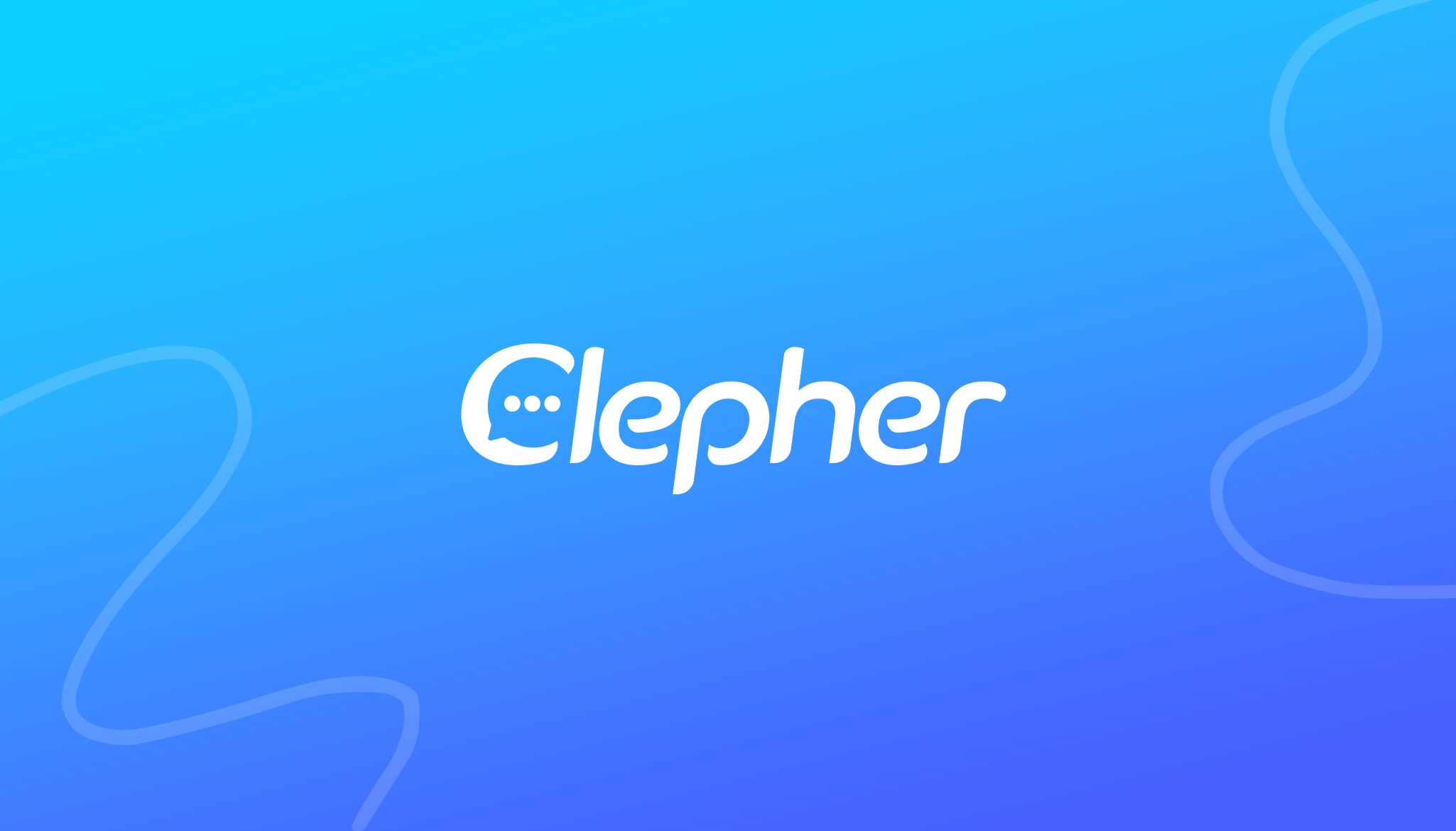We’ve all been there. You type a simple question into a chatbot, only to get that frustrating, “I don’t understand” reply. That single moment shows the massive gap between a basic, script-based bot and the kind of intelligent, helpful conversations people actually want.
The bridge across that gap is a technology called Natural Language Processing (NLP). Think of it as the engine that allows a chatbot to truly understand human language—typos, slang, and all—instead of just matching keywords. This guide gives you actionable insights into how this tech transforms your business.
Why Smart Chatbots Are Now a Business Necessity
A basic chatbot is like a simple calculator; it can only do the exact task it’s programmed for. Ask it “what is my order status,” and it works. But type, “yo where’s my stuff,” and the whole thing falls apart. This is where NLP comes in, turning that rigid tool into a flexible, problem-solving assistant.
Instead of hunting for fixed commands, an NLP-powered chatbot figures out the intent behind your words. It gets that “stuff” means “order” and “yo where’s” is a status request. The conversation feels natural and effortless for the user, which isn’t just a technical upgrade—it’s a strategic move that directly boosts customer satisfaction and your bottom line.
Moving Beyond Basic Scripts
The demand for more human-like interactions is why this field is blowing up. The natural language processing market is on track to hit around $48.79 billion in 2025 and is expected to soar past $1 trillion by 2035. This explosive growth isn’t just hype; it’s driven by businesses realizing that smarter automation is the key to better service and marketing. You can explore more data on the NLP market growth to see why this tech is attracting so much investment.
A chatbot without NLP is just an interactive FAQ page. A chatbot with NLP is a conversational partner that can understand context, manage complex queries, and build genuine customer trust.
The Real-World Transformation
So, what does this actually look like for a business? It means turning dead-end chats into successful outcomes.
- For E-commerce: A customer typing “these shoes don’t fit, what now?” is understood as a return request, and the bot kicks off the process instantly. No waiting, no frustration.
- For SaaS Companies: A user stuck on setup who types “I’m lost on the dashboard” gets guided through the exact onboarding steps they need, heading off churn before it even starts.
- For Service Providers: A query like “need to change my appointment for next Tuesday” is correctly interpreted to reschedule the booking, not just cancel it.
By mastering chatbot natural language processing, you’re not just building assistants that answer questions. You’re creating automated partners that solve problems, drive sales, and create experiences that make customers want to come back. In today’s market, it’s no longer an optional feature—it’s the foundation of modern digital communication.
How Chatbots Actually Learn to Understand Us
Ever wonder how a chatbot can make sense of your messy, typo-filled questions? It’s not magic—it’s a structured process that teaches a machine to read and understand, almost like teaching a child. This is the core of chatbot natural language processing, and it’s how jumbled human language gets turned into clear, actionable commands.
To really get it, think of an NLP chatbot as a detective solving a case. The moment you type a message, the bot starts looking for clues to figure out what you really mean. This all happens in a series of lightning-fast steps.
This infographic shows just how far we’ve come, moving from those frustrating, basic bots to the intelligent, NLP-driven assistants that actually solve problems.

chatbots understanding us
As you can see, the jump from a simple scripted bot to a smart NLP bot is what turns a frustrating dead-end into a genuinely helpful conversation.
The Detective Work Behind Every Chat
Let’s break down how this “detective work” happens with a real-world example. Imagine a customer sends this message to your e-commerce bot:
“hey i need to exchange my new red shoes from order #54321, they’re too small“
A basic, keyword-driven bot would probably get stuck right there. But an NLP-powered chatbot? It immediately kicks off its investigation.
1. Tokenization: Breaking Down the Message First, the bot slices the sentence into individual words and punctuation marks, called tokens. This first step breaks the raw text into manageable pieces for analysis.
"hey""i""need""to""exchange""my""new""red""shoes""from""order""#54321"",""they're""too""small"
Think of this as laying out all the evidence on the table. It organizes the chaos.
2. Part-of-Speech Tagging: Understanding the Structure Next, the chatbot identifies the role of each token. It labels the nouns, verbs, adjectives, and so on to understand the sentence’s structure.
exchange(verb)shoes(noun)red(adjective)small(adjective)
This helps the bot grasp the core action (exchange) and the main subject (shoes). It’s how it knows the difference between “I want to buy shoes” and “I want to return shoes.”
Uncovering the Core Request
Once the bot understands the sentence structure, it zeros in on the most important information needed to get something done. This is where the real value of chatbot natural language processing shines, turning a casual message into a structured task.
3. Named Entity Recognition (NER): Finding Critical Information This is where the bot spots and extracts key pieces of data, or entities. These are the specific, need-to-know details required to fulfill the request.
- Product: red shoes
- Order Number: #54321
- Reason: too small
NER is the secret sauce that lets a bot pull an order number out of a long sentence or recognize a date without you having to explicitly say “this is the date.”
4. Intent Classification: Figuring Out the Goal Finally, the bot puts all the clues together to determine the user’s ultimate goal, or intent. Based on the verb “exchange” and the surrounding context, it confidently classifies this request with a “Return/Exchange” intent.
With the intent identified and the entities extracted, the chatbot now has a complete picture. It knows the user wants to exchange order #54321 because the “red shoes” are “too small.”
Now, it can respond intelligently. Something like, “I can help with that! Let’s start the exchange process for the red shoes in order #54321. I’ll just need to confirm a few details.” This entire process, from that first token to the final intent, happens in a fraction of a second. If you’re curious about the bigger picture, you can explore what Conversational AI is and how it works.
This structured process is precisely what makes modern artificial intelligence chatbots feel so intuitive. For a deeper dive into the mechanics, check out our complete guide on understanding how AI chatbots work. It’s this ability to deconstruct and interpret language that transforms a simple bot into a powerful business tool.
The Business Impact of Smarter Conversations
Understanding the tech is one thing, but what really matters is the bottom line. What results can it actually deliver? Putting a chatbot with natural language processing to work isn’t just a fancy tech upgrade—it’s a serious business move that pays for itself across the board. When your bots can hold smarter, more human-like conversations, the impact is almost immediate.
This is the shift that takes chatbots from being basic FAQ machines to core assets for growth. They become tireless team members working 24/7 to create better experiences and, ultimately, drive revenue.

business impacts of smarter conversations
Elevate the Customer Experience
The most obvious win from an NLP chatbot is instant, 24/7 support. Customers don’t have to wait for your business hours to get answers anymore. That immediate help makes a huge difference in satisfaction and keeps them coming back.
Practical Example: Imagine someone is on your e-commerce site at 2 AM with a question about a product. They ask, “Is this jacket waterproof?” An NLP bot gets it instantly and gives a straight, helpful answer. That simple interaction can save a sale that would’ve otherwise been lost to the morning.
This kind of positive experience is fueling massive market growth. The global chatbot market, valued at around $10.32 billion in 2025, is expected to explode to nearly $29.5 billion by 2029. Why? Because businesses are using AI to handle huge volumes of questions and deliver the seamless support that customers now demand. You can discover more insights on the natural language processing market to get a sense of just how big this opportunity is.
Drive Serious Operational Efficiency
It’s not all about the customer-facing side. NLP chatbots are also powerhouses for internal efficiency. By automating all the routine, repetitive questions, you free up your human agents to tackle the complex, high-value problems that really need a human touch.
This isn’t about replacing your team; it’s about making them better. When a bot handles the endless stream of “Where’s my order?” or “What’s your return policy?” tickets, your support crew can focus their energy on escalated issues, tricky customer complaints, or providing deep product guidance.
This strategic automation has a direct impact on the bottom line. It reduces the cost per interaction, improves agent productivity, and allows you to scale your support operations without a proportional increase in headcount.
Practical Example: A SaaS company uses an NLP bot to guide new users through setup. By answering common onboarding questions automatically, it cuts down on basic support tickets. This lets the human agents concentrate on helping advanced users with sophisticated features, which drives product adoption and keeps churn low.
Accelerate Revenue and Growth
Finally, a smart chatbot is a powerful sales and marketing engine. It works around the clock to engage potential customers, qualify leads, and nudge them through your sales funnel.
An NLP-powered chatbot doesn’t just answer questions; it actively drives conversions.
- Lead Qualification: It asks targeted questions to figure out if a website visitor is a good fit, then automatically schedules demos with your sales reps for the hot leads.
- Personalized Recommendations: By understanding a user’s needs and what they’ve been looking at, it can suggest relevant products, acting like a personal shopper.
- Cart Abandonment Recovery: It can pop up and engage users who are about to leave your site with a full cart, maybe offering a small discount or answering a last-second question to seal the deal.
How NLP Chatbots Impact Business Metrics
This table shows the direct, measurable improvements businesses can expect by implementing chatbots with natural language processing capabilities.
| Business Area | Metric | Improvement with NLP Chatbot | Example |
|---|---|---|---|
| Customer Support | First Response Time | Reduced from hours to seconds, providing instant 24/7 support. | A retail bot instantly answers “Do you ship to Canada?” at 11 PM. |
| Operations | Cost Per Interaction | Lowered by automating up to 80% of routine tier-1 inquiries. | An airline’s bot handles thousands of flight status checks daily. |
| Sales | Lead Conversion Rate | Increased by engaging website visitors proactively and qualifying leads in real-time. | An insurance bot pre-qualifies a visitor for a policy and books a call. |
| Customer Experience | Customer Satisfaction (CSAT) | Improved by providing fast, accurate, and always-available answers. | A user gets an immediate, helpful response instead of waiting on hold. |
Ultimately, a chatbot that truly understands language isn’t just a tool; it’s a strategic asset that delivers tangible ROI.
By integrating chatbot natural language processing, businesses turn every customer interaction into an opportunity. Each conversation becomes a chance to build loyalty, boost efficiency, and directly grow revenue. It’s simple: smarter bots lead to a smarter, more profitable business.
Why NLP Chatbots Are The Future of Chatbots
Chatbot natural language processing (NLP) has transformed how businesses engage with customers. By leveraging AI technology and large language models (LLMs), chatbots can understand and respond to human language in a way that feels natural and human-like. This leads to improved customer support and enhances the overall chatbot experience.
The benefits of NLP chatbots extend beyond just conversational interactions. With advanced analytics, businesses can gain insights into customer queries and preferences, enabling them to optimize their services. NLP-powered chatbots can efficiently analyze human conversation, allowing them to automate responses to common customer inquiries. This not only streamlines operations but also significantly reduces response times, ensuring that customer queries are addressed promptly. By implementing such intelligent chatbot solutions, companies can enhance their customer service while reducing the workload on human agents.
Use Cases of NLP Chatbots
The real magic of chatbot natural language processing isn’t the tech itself, but how it shapeshifts to solve real-world problems. It’s a flexible engine you can tune for just about any industry, turning a cool concept into a tool that actually makes you money.
This adaptability is exactly why businesses are jumping on board. North America alone holds about 30% of the global market share, which shakes out to a value of around $15.21 billion. That’s a massive investment, showing just how critical this technology has become for gaining a competitive edge. You can explore the full breakdown of NLP market statistics to see the trends for yourself.
But enough with the big picture. Let’s look at how this plays out on the ground.

use cases of NLP chatbots
E-commerce: Product Discovery and Sales
For an online store, a smart chatbot is more than just a help desk—it’s your best salesperson, working 24/7. It can greet a customer, figure out what they want, and guide them straight to the checkout.
Practical Example:
- Customer: “I’m looking for a warm jacket for a winter trip to the mountains.”
- Chatbot: “Great! Do you prefer something lightweight like down, or a heavier, waterproof shell?”
- Customer: “Waterproof is a must.”
- Chatbot: “Perfect. I have three waterproof jackets that our customers love for cold weather. Would you like to see them?”
The bot uses intent classification to know the user is ready to shop. Then, it uses entity recognition to grab keywords like “warm,” “jacket,” and “waterproof” to show the most relevant products. No dead ends, just a smooth path to purchase.
Healthcare: Appointment and Information Management
In a field like healthcare, where every detail matters, NLP bots are a game-changer for efficiency and security. They take the routine tasks off the front desk’s plate so staff can focus on actual patient care.
A well-built healthcare bot can schedule appointments, answer common questions about services, and send out pre-visit instructions—all while keeping patient data completely secure.
Practical Example:
- Patient: “I need to book my annual checkup with Dr. Smith for next week.”
- Chatbot: “Of course. Dr. Smith has openings on Tuesday at 10 AM and Thursday at 2 PM. Which works best for you?”
- Patient: “Tuesday is good.”
- Chatbot: “Excellent. I’ve scheduled your annual checkup with Dr. Smith for next Tuesday at 10 AM. You’ll receive a confirmation email shortly.”
The bot instantly understands the intent (scheduling), the doctor (Dr. Smith), and the timeframe (next week). This quick, automated back-and-forth saves a ton of time for everyone involved.
Financial Services: Fraud Detection and Support
Banks and financial institutions need to be fast and secure. NLP-powered chatbots deliver on both fronts. Customers get instant answers about their accounts, and the bot acts as a vigilant watchdog for suspicious activity.
Practical Example:
- Customer: “What’s my checking account balance?”
- Chatbot: “Your current checking balance is $1,245.50. I also see a pending charge of $500 from an online merchant you haven’t used before. Does that look correct?”
- Customer: “No, that’s not me!”
- Chatbot: “Thank you for confirming. I have flagged the transaction and temporarily frozen your card. A fraud specialist will call you within the next 15 minutes to resolve this.”
The bot handles the simple entity recognition task (checking a balance) but is also smart enough to spot an anomaly and kick off a security workflow.
Internal HR: Employee Onboarding and Support
Don’t forget how chatbot natural language processing can transform things internally. An HR bot acts as an on-demand resource for employees, knocking out common policy questions and handling simple administrative requests. The impact here is huge, with 78% of companies using AI reporting that it makes finding top talent easier.
Practical Example:
- Employee: “How many vacation days do I have left this year?”
- Chatbot: “Looking that up now… You have 7 vacation days remaining. Would you like to submit a time-off request?”
By plugging into internal HR systems, the bot gives a personalized, accurate answer in seconds. Each of these examples proves the same point: with the right approach, an NLP chatbot becomes a core asset in any industry.
Choosing The Right Chatbot NLP Platform
Picking the right technology is the bedrock of your chatbot’s success. It’s what separates a genuinely helpful assistant from a frustrating digital dead-end. This choice goes way beyond a simple feature list—it’s about finding a platform that syncs up with your business goals, your team’s technical skills, and where you plan to be in a few years.
This decision really comes down to two main paths: building a custom solution from scratch or using a ready-made platform.
Build vs. Buy: The Core Dilemma
- Building a custom NLP engine gives you ultimate control. You can fine-tune every last detail and create highly specialized functions. But this path is demanding. It requires a team of skilled data scientists, a serious budget, and a long development timeline. For businesses with truly unique needs, this is a powerful option.
- Using a ready-made platform like Clepher gives you a massive head start. These tools are designed to get you up and running fast, often with intuitive, no-code interfaces. You get access to a pre-trained NLP engine that already understands common user requests, saving you months of work and significant cost. This is the perfect choice for most businesses that need to see results now.
Key Questions To Guide Your Decision
Whether you decide to build or buy, your evaluation should boil down to a few critical factors. Use this checklist to make a choice that serves your business today and supports it tomorrow.
- How accurate is the NLP engine? Can it handle slang, typos, and weird phrasing? Always ask for a demo using real-world examples from your industry. A platform’s ability to correctly figure out what a user wants is its most important job.
- How easy is it to train and customize? An NLP model is never “finished.” You’ll constantly need to refine its understanding based on actual customer conversations. Look for a system that makes this easy. Understanding how to train an AI chatbot is key to long-term success.
- Does it integrate with your existing tools? Your chatbot is useless if it can’t talk to your other systems. To be effective, it needs to connect with your CRM, helpdesk software, and e-commerce platform. Check for native integrations or a solid API to make sure data can flow smoothly.
- Can it scale as your business grows? The platform you choose today has to support your needs tomorrow. Make sure it can handle a flood of new conversations without slowing down. Good scalability prevents the headache of having to switch platforms right when your business is taking off.
Actionable Takeaway: The best chatbot platform is one that grows with you. It should be able to handle an increase in conversation volume and complexity without a drop in performance or a spike in costs.
If you’re looking into a fully custom build, you might want to bring in some outside help. Leveraging specialized AI development services can fill any gaps in your team’s expertise. Making the right platform choice is a strategic move that directly impacts your ROI.
Best Practices for a Winning Chatbot Strategy
Having a powerful chatbot natural language processing tool is only half the story. To see real value, you need a smart strategy guiding every interaction. Without a clear plan, even the most advanced bot can quickly become a frustrating dead-end for your customers—and a wasted investment for you.
Think of your chatbot strategy as a blueprint. It ensures every part of your bot is built with a purpose, leading to a better customer experience and stronger business results.
Define a Single, Clear Purpose
The biggest mistake businesses make is trying to build a chatbot that does everything. This “jack-of-all-trades” approach usually creates a bot that’s a master of none, leaving users confused.
Your first and most crucial step is to define one primary goal.
Is your bot’s main job to answer frequently asked questions? Qualify sales leads? Book appointments? Start with a single, high-impact use case and absolutely nail it before adding more.
Actionable Takeaway: Instead of a bot that tries to handle sales, support, and billing, build one that excels at instantly answering “Where is my order?” This tight focus ensures it performs flawlessly, building user trust from the get-go.
Design a Personality That Reflects Your Brand
Your chatbot is often the first “voice” a new customer interacts with, making its personality a direct reflection of your brand. A bot for a playful e-commerce store should sound completely different from one for a serious financial institution.
Take the time to define its tone of voice. This creates a consistent and engaging experience.
- Friendly and Casual: Uses emojis, contractions, and a lighthearted tone. Perfect for lifestyle or direct-to-consumer brands.
- Professional and Direct: Sticks to clear, formal language. Ideal for B2B, finance, or healthcare industries where clarity and authority are key.
Establish a Seamless Handoff to Human Agents
Let’s be real: even the smartest NLP bot will run into a question it can’t answer. A seamless handoff process isn’t just a nice-to-have; it’s non-negotiable.
Your bot must be trained to recognize when a user is frustrated or when a query is too complex. When that happens, it needs to smoothly transfer the conversation—along with its entire context—to a live agent.
This simple step prevents customers from having to repeat themselves, which is one of the biggest sources of frustration in customer service. The transition should feel like a natural escalation, not a system failure.
Finally, remember that a chatbot is never “finished.” Regularly review conversation logs to see where users get stuck, identify new questions, and use that data to refine your bot’s understanding. For a complete playbook, explore our detailed guide on essential chatbot best practices to optimize your strategy.
NLP Algorithms for Chatbots
NLP algorithms are essential for chatbots to understand and process natural language. These algorithms enable chatbots using NLP to engage users effectively by interpreting queries and providing relevant responses. There are primarily two types of chatbots: rule-based chatbots and AI-powered chatbots. Rule-based chatbots operate on predefined rules, while AI chatbots leverage generative AI and advanced NLP solutions to learn from interactions.
Enterprise chatbots benefit significantly from NLP technology, allowing them to handle complex queries and enhance user experience. By implementing NLP tools, businesses can deploy a chatbot that utilizes contextual understanding, thus improving the efficiency of customer service. NLP chatbots for enterprise are designed to streamline operations and provide insights through real-world use cases.
Chatbots built on AI-powered platforms, particularly those that are powered by large language models, can understand user intent with greater accuracy. These chatbots can handle a variety of tasks, from simple FAQs to complex problem-solving. The use of natural language processing enables chatbots to deliver personalized experiences, making them invaluable for customer interactions.
In summary, the implementation of NLP algorithms is critical for the development of effective chatbots. As businesses continue to explore chatbot use cases, understanding how NLP works will allow them to leverage AI chatbot platforms for better customer engagement and satisfaction.
Curious About NLP Chatbots? Let’s Tackle Your Top Questions!
Even with the best strategy, diving into new tech always brings up a few practical questions. Let’s clear the air and tackle some of the most common things businesses ask about chatbot natural language processing.
Conclusion
In summary, the integration of natural language processing into chatbot technology has transformed the landscape of digital communication. By utilizing NLP, businesses can deploy intelligent chatbots that leverage machine learning and deep learning techniques to enhance user interactions. These AI-powered chatbots can effectively use natural human language, providing personalized responses and improving customer experiences. The growing adoption of NLP-based chatbots in enterprise environments highlights their potential in various use cases, from customer support to data collection. As the capabilities of AI agents continue to evolve, the future of chatbot development promises even more innovative solutions, paving the way for advanced chatbots that can understand and engage with users in a more natural and intuitive manner.
Ready to build smarter conversations that drive real business results? Clepher provides the intuitive, no-code platform you need to launch a powerful NLP chatbot on your website, Messenger, and Instagram in minutes, not months. Start your free trial today and see the difference for yourself.
Related Posts



